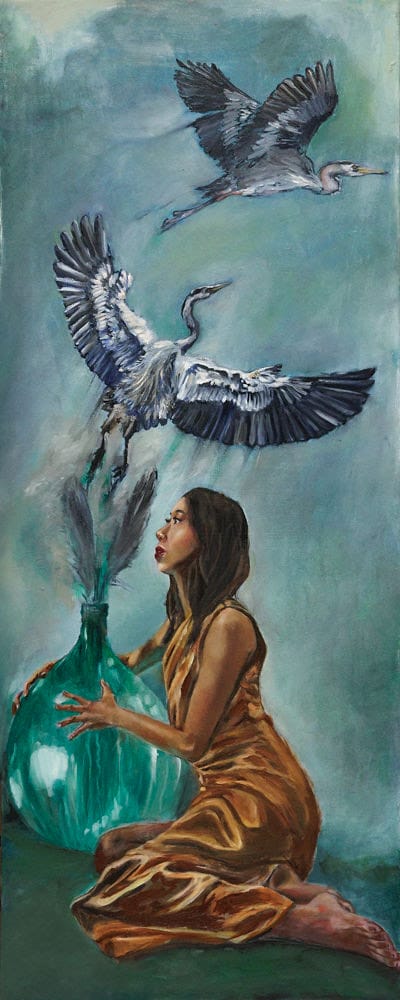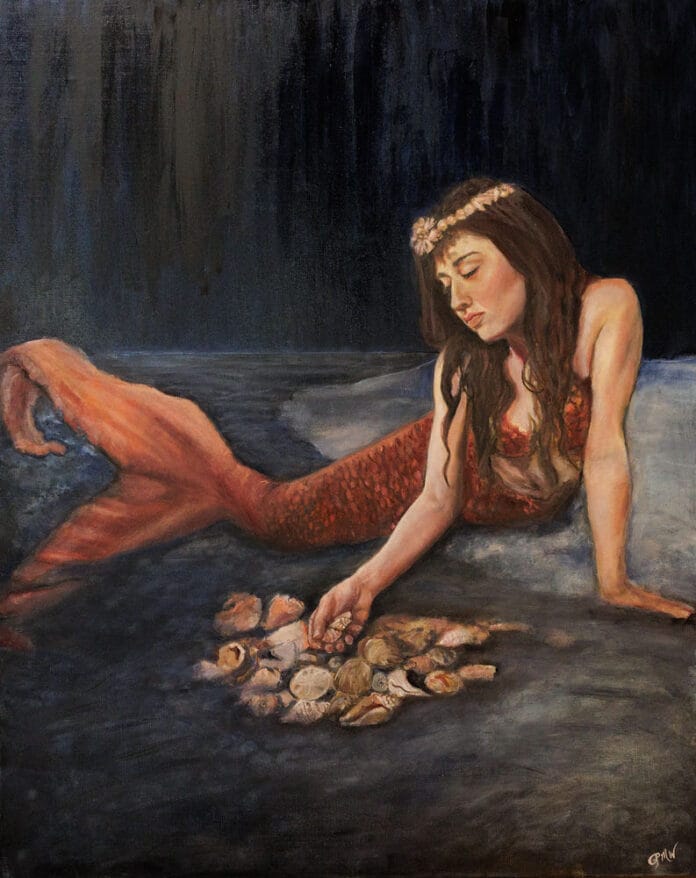In a world increasingly detached from nature’s rhythms, the work of Paula Michele Wagoner invites us to return: to the shorelines, the stories, and the subtle ecosystems that too often slip from view. Through her oil paintings, Wagoner builds mythic narratives that echo personal memory and collective ecological concerns, weaving in feminine power, transformation, and the sacred tension where water meets land.
Her works The Littoral Thread and The Heron Maker stand out for their spiritual resonance as much as their visual depth. They hum with tidal movement and carry a quiet warning of what we stand to lose.
The Littoral Thread: Where Myths and Mermaids Merge
In The Littoral Thread, a Gulf mermaid emerges, not the glossy fantasy of children’s tales but a solemn figure shaped by shells and tides. She dissolves into the ocean’s motion, her form both fragile and enduring. Around her, shells cling and unravel, echoing the delicacy of the coastal ecosystems Wagoner seeks to protect.
This piece evokes transformation, silent, powerful, and inevitable. The mermaid embodies both myth and the human longing for meaning in the face of vanishing beauty. The threads that bind her to the sea mirror the ties that connect all life to the health of our waters. In Wagoner’s hands, these threads feel both tangible and symbolic, pulsing with connection and vulnerability.
The Heron Maker: Guardians in Flight
The Heron Maker complements this vision but reaches upward, both literally and thematically. A woman releases herons from a vessel, as if shaping them from clay or summoning them from an unseen realm. They rise like prayers or emissaries, wings stretched toward a distant sky.

This act of creation feels mystical and maternal. Herons, long symbols of patience and vigilance, become reminders of what must be nurtured if it is to thrive. In the shadow of climate change and habitat loss, the question lingers: If we could make new herons, could we repair what we have undone?
Littoral Spaces: Where Stories and Tides Meet
The idea of littoral spaces, those narrow bands where land and sea meet, lies at the heart of Wagoner’s work. Having grown up on Sanibel Island, Florida, she knows these in between places intimately: tidal flats, mangrove roots, and shell-laden shores. They are both real and symbolic thresholds, places where stories begin and transformations unfold.
Such spaces remind us that damage can accumulate quietly, just out of sight. They ask us to pause, to notice the subtle beauty that clings to the edges of our world.
An Artist Rooted in Place
Raised on the Gulf Coast, Wagoner’s early life was shaped by tidal waters, shorebirds, and the slow poetry of nature. These memories grew into an artistic language that blends conservation, literature, and myth. Working now in Naples, Florida, she continues this exploration with a careful hand and a vivid imagination.
Her process combines traditional oil painting with modern storytelling. She works with live
models and photographs, capturing real-world details and infusing them with allegory and
symbolism. Her layered brushwork invites the viewer to look more deeply, to find meaning
beneath the surface.
Painting as Witness
What sets Wagoner’s work apart is its quiet form of environmental witness. She does not shout warnings; she paints what remains, what could vanish, and what still asks for care.
Her figures, whether mermaids or heron makers, hold memory, myth, and the fragile promise of what might endure.
A Call to Wonder and Care
In a time of ecological urgency, Wagoner offers a vision rooted in wonder and reverence. Her art reminds us that these delicate thresholds, both physical and spiritual, deserve our attention. Like her herons rising on painted wings, her work carries hope and a call to stewardship.


